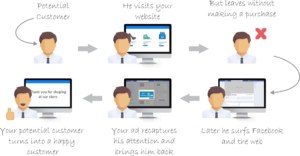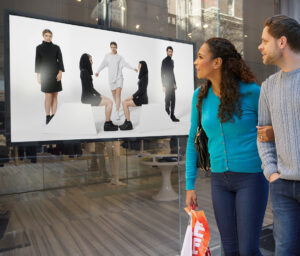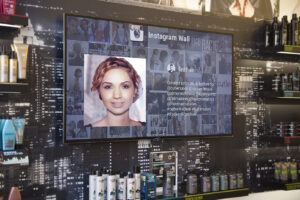Digital signage is often discussed as a tool to improve physical, in-store experiences with customers. However, digital signage is a tool that goes beyond just offline experience; it’s a key to creating hybrid offline and online experiences.
First, to understand hybrid experiences, brands need to consider the benefits of online vs offline shopping for customers. Why, even as online shopping grows, do consumers still make purchases in physical stores?

Online shopping is convenient.
Consumers are able to quickly buy almost anything from almost anywhere. And with online shopping apps, such as Amazon, that save credit card information, online shopping is as easy as 1 tap. Online shopping also allows for easy comparison of prices and customer reviews. “Is this the best price for a TV?” “Do people actually like the smell of this soap?” These are just examples of the dozens of questions the internet can answer for shoppers in seconds.
Online shopping also allows consumers time to consider a new product before buying. Consider this example:
A consumer is browsing the internet and stumbles upon a pair of shoes.
They like the shoes so they save the page for later.
Then, they watch an episode (or three) of Netflix.
After, they search Pinterest and Instagram for different looks and trends associated with the shoes.
Then, a few hours later, they go back to browsing the internet and check Facebook…
And then voila!
A retargeting ad pops up reminding them of the shoes. Now, the shoes aren’t a rash purchase. The consumer has seen the shoes a few times before. They’ve deeply considered the shoes. They’ve seen other wearing the shoes. So now, they buy the shoes.

However, for in-store consumers who are window shopping or “just looking”, any purchase made is a risk for buyers regret. In-store shopping also doesn’t provide the same in-depth understanding of a new product that online shopping may. Consumers want to know more about a product before buying it.
But, despite the barriers to purchase, many people do continue to buy from physical stores. The biggest reason for this, and the biggest reason consumers shop offline, is that they need to touch and feel a product. Consumers often need to see a product for themselves before they can commit to it.
Clothes need to be tried on, materials need to be felt, perfumes need to be smelled…

And ultimately, people buy on emotion.
And sensory triggers cause emotional responses. Since physical stores provide a more multi-sensory experience than online shopping, consumers still shop offline.
While the benefits of online and offline shopping are both appealing, the future of customer experience relies on brands to combine these into a hybrid experience. Hybrid experiences must cater to the logical and convenience needs of the online shopper as well as the sensory and emotional needs of the offline shopper. So how can brands connect these two worlds of shopping?
Well, most online retailers are already realizing the importance of this. Think of all the brands that offer “try it for 30 days or it’s free” or “Free shipping on returns”. These brands want to alleviate the risk of buyer’s remorse and allow customers the chance to touch and feel a product before committing finanically.
So now, physical stores must do the same.
Physical stores must adopt strategies to create hybrid experiences for their customers that bring the online shopping experience into stores. The best tool for brands to do this is:
Digital Signage.

At face value, digital signage simply seems like a high-tech replacement for traditional ads in-stores but this is not true. Digital signage capabilities span beyond just promoting ads. Digital signs can be used to bring the online shopping experience in-stores.
Product Reviews. Digital screens can be used to display online positive reviews and customer photos. Displaying these in-stores confirms to in-store shoppers that other people like the product and recommend it to others. This is powerful since 92% of consumers will believe recommendations from friends and family over all forms of advertising (Nielsen).
Social Media Engagement. Digital screens can be equipped with social media walls. These walls can display hashtags, social feeds and more to engage customers. The best part – social media walls engage both online and offline consumers. For customers in stores, they can post photos of the latest products while shopping which can then be seen by customers online. Similarly, customers online can post photos of products they own and show how they use them which can then be seen by customers in-stores. Social media displays are a great connector between online and offline experiences.

Trends. Similar to the idea of social media walls, displaying trends on digital screens allows in-store shoppers to still get the online experience of seeing ways to use, style, or wear a product. Digital signage can display RSS feeds with specific product trends or even custom “How to” or “Trending Now” videos.
Upselling. Thinking back to the shoe example, retargeting ads were a key part of the buyer decision making process. The retargeted ads served to remind the consumer about the shoes and ultimately made the customer feel familiar enough with the shoes to buy. Similarly, digital signage in-stores can remind customers of products and use up selling techniques to “retarget” them. For example:
If a customer see a pair of shoes in the window display, and then the front of the store, they may forget about them when they’re in the dressing room trying on something else.
However, with digital signage, a screen in the dressing room can display a style guide that features the shoes along with other popular items. This serves as a not only a reminder to the customer, but also as an inspiration to go back and try on the shoes.
These are just a few examples among many of how to bring online experience into retail stores. Overall, brands should aim to create hybrid experiences and digital signage is the tool to accomplish just that.
To learn more about how to use digital signage in retail locations, check out our product information.

